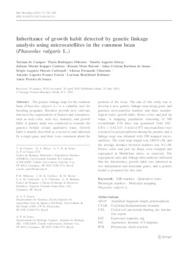Inheritance of growth habit detected by genetic linkage analysis using microsatellites in the common bean (Phaseolus vulgaris L.).
Inheritance of growth habit detected by genetic linkage analysis using microsatellites in the common bean (Phaseolus vulgaris L.).
Autoria: CAMPOS, T. de; OBLESSUC, P. R.; SFORÇA, D. A.; CARDOSO, J. M. K.; BARONI, R. M.; SOUSA, A. C. B. de; CARBONELL, S. A. M.; CHIORATTO, A. F.; GARCIA, A. A. F.; RUBIANO, L. B.; SOUZA, A. P. de
Resumo: The genetic linkage map for the common bean (Phaseolus vulgaris L.) is a valuable tool for breeding programs. Breeders provide new cultivars that meet the requirements of farmers and consumers, such as seed color, seed size, maturity, and growth habit. A genetic study was conducted to examine the genetics behind certain qualitative traits. Growth habit is usually described as a recessive trait inherited by a single gene, and there is no consensus about the position of the locus. The aim of this study was to develop a new genetic linkage map using genic and genomic microsatellite markers and three morphological traits: growth habit, flower color, and pod tip shape. A mapping population consisting of 380 recombinant F10 lines was generated from IAC-UNA × CAL143. A total of 871 microsatellites were screened for polymorphisms among the parents, and a linkage map was obtained with 198 mapped microsatellites. The total map length was 1865.9 cM, and the average distance between markers was 9.4 cM. Flower color and pod tip shape were mapped and segregated at Mendelian ratios, as expected. The segregation ratio and linkage data analyses indicated that the determinacy growth habit was inherited as two independent and dominant genes, and a genetic model is proposed for this trait.
Ano de publicação: 2011
Tipo de publicação: Artigo de periódico
Unidade: Embrapa Acre
Palavras-chave: Agronomic traits, Beans, Características Agronômicas, Chromosome mapping, Crescimento, Feijão, Fitomejoramiento, Frijoles, Growth habit, Hábito de crecimiento, Interação genética, Mapa, Mapeo de cromosomas, Marcador genético, Marcador microssatélite, Melhoramento genético vegetal, Microsatellite repeats, Phaseolus vulgaris, Plant breeding, Repeticiones de microsatélite
Observações
1 - Por padrão são exibidas publicações dos últimos 20 anos. Para encontrar publicações mais antigas, configure o filtro ano de publicação, colocando o ano a partir do qual você deseja encontrar publicações. O filtro está na coluna da esquerda na busca acima.
2 - Para ler algumas publicações da Embrapa (apenas as que estão em formato ePub), é necessário ter, no celular ou computador, um desses softwares gratuitos. Sistemas Android: Google Play Livros; IOS: iBooks; Windows e Linux: software Calibre.
Acesse outras publicações
Acesse a Base de Dados da Pesquisa Agropecuária (BDPA) para consultar o acervo completo das bibliotecas da Embrapa.

